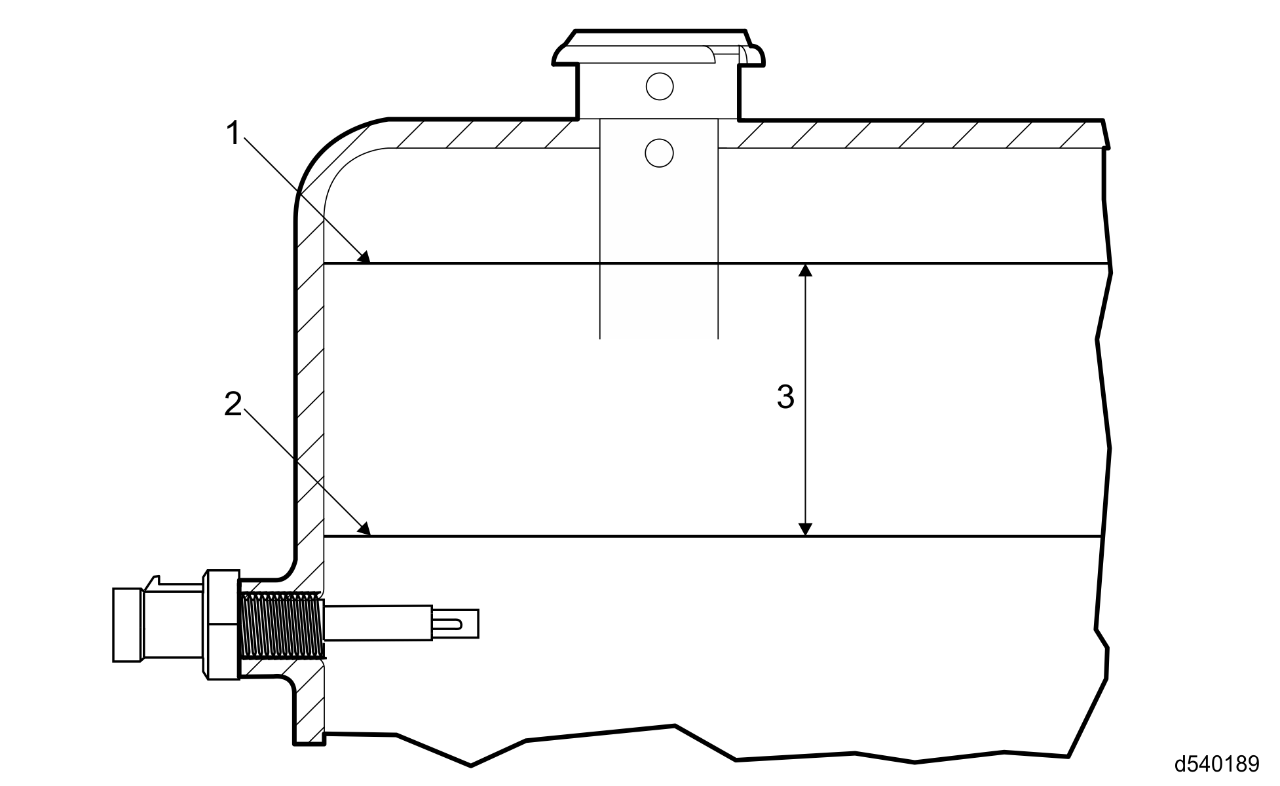This instruction show you guide on how to repair coolant loss for Detroit Diesel GHG14 engine.
Preparations:
2024 Detroit Diesel Diagnostic Link DDDL 8.19 8.09 Free Download
Procedures:
Note : Prior to diagnosing a coolant loss complaint, make sure that the coolant is not being unnecessarily overfilled. The min/low and max/full marks on the coolant surge tank represent the acceptable operating range of the coolant level. During normal operation, the coolant level will expand and contract between the two lines, depending on temperature. No coolant needs to be added if the coolant level is at the number two line. Overfilling the coolant reservoir will cause the surge tank to push coolant out.
1 MAX/FULL Mark
2 MIN/LOW Mark
3 Operating Range

Check as follows:
1.Are any Original Equipment Manufacturer (OEM) components leaking coolant externally?
1a Yes; inspect the vehicle for the source of the coolant loss and consult OEM procedures for repair instructions.Detroit Diesel Diagnostic Link DDDL
1b No; Go to step 2.
2.Inspect the vehicle for any aftermarket components plumbed into the cooling system. Are there any aftermarket components plumbed into the cooling system on the vehicle?
2a Yes; Go to step 3.
2b No; Go to step 4.
3.Inspect the aftermarket components; refer to OEM guidelines. Are aftermarket components the source of coolant loss?
3a Yes; repair as necessary.
3b No; Go to step 4.
4.Pressure test the surge tank cap(s). Do the cap(s) hold the correct rated pressure?
4a Yes; Go to step 5.
4b No; repair as necessary.
5.Check engine coolant fan operation. Does the fan function correctly?
5a Yes; Go to step 6.
5b No; repair as necessary.
6.Pressure test the cooling system and inspect for coolant leaks. Is the engine leaking coolant externally?
6a Yes; Go to step 7.
6b No; Go to step 13.
7.Is the external leak at the cylinder head to cylinder block joint?
7a Yes; remove the cylinder head.
For DD13, Removal of the DD13 Cylinder Head Assembly
For DD15/16,Removal of the DD15 and DD16 Cylinder Head Assembly
Go to step 8.
7b No; inspect the engine for the source for the coolant leak and make the repair.
8.Is the vehicle equipped with a GHG14 engine?
8a Yes; Go to step 9.
8b No; Go to step 11.
9.Inspect the cylinder head gasket coolant grommet(s) for damage. Are the grommet(s) damaged?
9a Yes; replace the cylinder head gasket.
9b No; Go to step 10.
10.Visually inspect the cylinder liners for scuffs. Are any of the liners scuffed?
10a Yes; replace the scuffed liner(s). Removal of the Cylinder Liner .
10b No; test the cylinder liner upper O-ring. Refer to section “Testing of the Cylinder Liner Upper O-Ring” .
11.Inspect the cylinder head gasket coolant grommet(s) for damage. Are the grommet(s) damaged?
11a Yes; replace the cylinder head gasket. Go to step 12.
11b No; Go to step 12.
12.Visually inspect the cylinder liners for scuffs. Are any of the liners scuffed?
12a Yes; replace the scuffed liner(s),Removal of the Cylinder Liner and test the cylinder liner upper O-ring, Testing of the Cylinder Liner Upper O-Ring
12b No; test the cylinder liner upper O-ring, Testing of the Cylinder Liner Upper O-Ring
13.Is the vehicle equipped with an EPA07 engine?
13a Yes; Go to step 15.
13b No; Go to step 14.
14.Is there coolant contamination in the Diesel Exhaust Fluid (DEF)?
14a Yes; replace the DEF tank header assembly. Select the proper tank:
Removal of the EPA10 13 and 23 Gallon Diesel Exhaust Fluid Tank Header Unit
Removal of the GHG14 13 and 23 Gallon Diesel Exhaust Fluid Tank Header Unit
Removal of the GHG14 Six-Gallon Diesel Exhaust Fluid Tank Header
14b No; Go to step 15.
15.Is there coolant contamination in the oil?
15a Yes; Coolant in Oil
15b No; Go to step 16.
16.Is there coolant contamination in the fuel?
16a Yes; Fuel in Coolant/Coolant in Fuel
16b No; Go to step 17.
17.Pressure test the Exhaust Gas Recirculation (EGR) cooler. Does the EGR cooler pass testing and inspection?
Testing of the DD13 Exhaust Gas Recirculation Cooler Water Manifold Assembly – In Chassis
Testing of the DD15 and DD16 Exhaust Gas Recirculation Cooler – In Chassis
17a Yes; release the vehicle and monitor coolant consumption. During normal operation, the coolant level will expand and contract. Overfilling the coolant reservoir will cause the surge tank to push coolant out.
17b No; replace the EGR cooler.
For DD13, Installation of the DD13 EGR Cooler Water Manifold Assembly
For DD15/16,Installation of the DD15 and DD16 Exhaust Gas Recirculation Cooler
More repair cases for Detroit Diesel engines,please refer to:Detroit Diesel Engine Repair